With powerful, pure sine wave inverters and a plethora of 12V appliances on the market, it is possible to run a whole lot of stuff from your RV battery when off the grid. This is provided you have the battery capacity to do it. When boondocking, it’s important to be able to determine how much battery power your RV has left at any given time.
Many RVs have a display of lights that tell you approximately how full your batteries are. But you may have noticed that the four lights aren’t an incredibly accurate measure of the battery power your RV has left. Below you will find several methods you can use to accurately determine your remaining battery power for both lead-acid and lithium batteries.
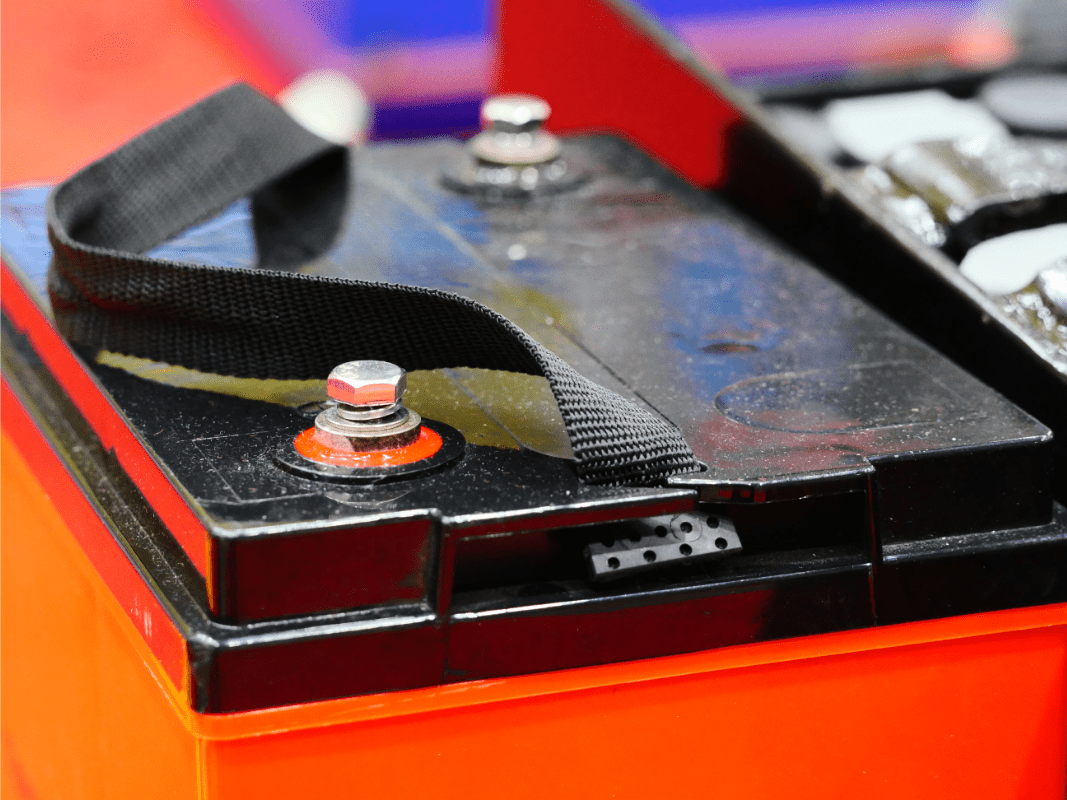
All About Lead-Acid Batteries
Lead-acid (LA) batteries are the most common type of battery you will find on an RV. Though your car or truck uses the same type of battery, your RV will most likely have deep-cycle 12V batteries. The difference is the starter battery for your engine is intended to deliver a lot of power very quickly to start your motor. In contrast, deep-cycle batteries are designed to give a steady current or a long period to run your RV lights, furnace fan, etc.
You’ll find three styles of deep-cycle lead-acid batteries in the RV world:
- 12V flooded lead-acid batteries (the kind you have to add water to)
- 12V sealed Absorbent Glass Mat (AGM) batteries
- 6V deep-cycle golf cart batteries (typically flooded type)
Before determining the charge state of your LA batteries, it is a good idea to know what kind of battery you have. If you don’t already know your battery type, this information should be on the battery label.
Depth of Discharge (DoD) of an RV Lead-Acid Battery
Regardless of the type of lead-acid battery you have, the recommended maximum depth of discharge is 50%. In other words, your battery will last the longest when you don’t drain it below 50%. It probably won’t hurt the battery too much if you used 60-70% of the battery capacity every once in a while, but doing so frequently will shorten the battery’s lifespan.
In effect, when determining the remaining battery power of a lead-acid battery, you are trying to determine how close you are to 50% rather than 0%.
How to Use a Multimeter to Determine Battery Power
A multimeter is one of the easiest ways to get an accurate reading of your battery’s current charge state.
Here’s how to use a multimeter to determine your RVs battery power:
- Set the multimeter to the DC setting. Every multimeter is a little different in layout so you may need to refer to the manual of your meter to find the right setting for 12V or 6V batteries. Generally, you will find it near a “V” that has the DC symbol “⎓” next to, or below it (meaning “DC volts”).
- Touch the red probe to the red or positive side of the battery and the black probe to the black or negative side of the battery.
- The meter will display the battery voltage.
- Use the table below to determine your battery power.
Note: You will get the most accurate reading when testing a battery that has been resting (not charged or discharged) for 12-24 hours.
Lead-Acid Battery State-of-Charge Table
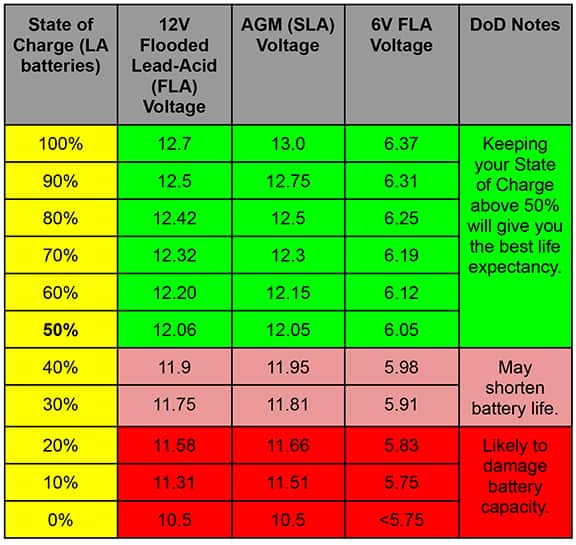
How to Use a Specific Gravity Reading To Determine RV Battery Power
A specific gravity test is considered the most accurate way to assess your battery power. It can only be done on a flooded lead-acid battery because AGM batteries are sealed and there is no way to get to the electrolyte solution.
What is a specific gravity test?
The electrolyte solution in a LA battery is made up of sulfuric acid and distilled water. As you use the battery, the acid gets converted into other chemicals and gets used up. When you charge the battery, the process is reversed and those chemicals get turned back into sulphuric acid.
Because the amount of acid mixed with distilled water changes based on the battery’s charge state, so does the density of that liquid. You can measure that density with a hydrometer. The most common type of battery hydrometer looks like a turkey baster with a little float device inside.

One of the easiest to use is an EZRED Battery Hydrometer. You can find them online and in most auto-part stores. The nice thing about the EZRED hydrometer is it’s a temperature compensating hydrometer.
How to Measure The Specific Gravity
- Safety first! Battery acid is very harmful to your skin. Use:
- Protective eyewear
- Thick gloves
- Closed-toe shoes
- Carefully take off all of the covers.
- Squeeze the bulb and carefully insert the battery hydrometer into the cell. Release the bulb to draw fluid into the hydrometer until the battery electrolyte solution fills the hydrometer to the maximum level.
- Read the measured value on the device and write that value down.
- Continue onto the next cell and repeat until you have measured all the battery cells.
- All the cells should read about the same. If there is .050 or more difference in the specific gravity reading between the highest and lowest cell, you may have a weak or dead battery cell.
- Refer to the specific gravity table to find your current battery power.
Specific Gravity Table
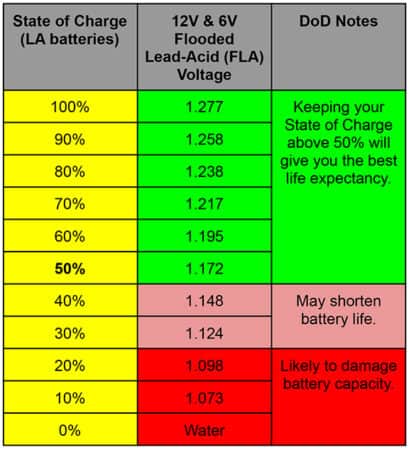
Note: A professional battery hydrometer will give you more pinpointed readings than the ranges on the EZRED model. If you choose to measure your battery power with this method, make sure to get one with a built-in thermometer and follow the directions carefully to arrive at an accurate reading.
RV Lithium-Ion Batteries
Lithium batteries are becoming more popular with RVers—especially those interested in solar systems and boondocking. Like AGM lead-acid batteries, lithium batteries are sealed and maintenance-free. Of course, they are based on using lithium rather than lead in their makeup, and they have several advantages over lead-acid batteries.
There are different types of lithium-ion batteries used in various applications. The most common type of 12V lithium battery found in RVs uses lithium iron phosphate. You will see this marketed using the compound’s chemical formula LiFePO4. This type of lithium battery has proven to be safe, reliable, and longer-lasting than lead-acid batteries. If you are thinking of switching over to LiFePO4 batteries, have a look at Everything You Need to Know About Installing Lithium Batteries in an RV.
Deeper Depth of Discharge
One big advantage LiFePO4 batteries have over lead-acid is it has a much deeper DoD. While lead-acid shouldn’t be discharged below 50%, a lithium battery can be discharged down further without seriously harming the battery. Although experts recommend only discharging it down to 20% regularly to get the longest lifespan.
In practice, that means your 100 amp-hour lead-acid battery only has 50Ah of usable battery power, while just about all 100Ah are usable when using lithium.
So, How Do You Determine How Much Battery Power You Have Left When Using Lithium?
There are no fluids to get into for specific gravity tests when checking lithium batteries, so you will want to use the multimeter method to measure your battery’s charge state via voltage. Touch the red probe to positive and black to negative after setting the multimeter to read DC volts and note the battery’s voltage. Use the table below to determine your remaining battery power.
Lithium Battery State-of-Charge Table
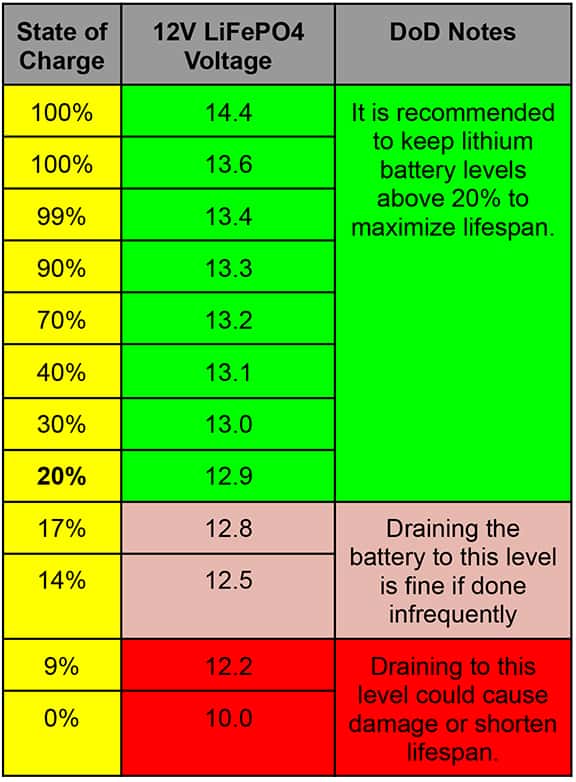
The Easiest Way to Determine How Much Battery Power Your RV Has Left
If at any point while reading this article you thought Hey, I can get a fix on my location within 10ft using satellites and my phone. Hasn’t someone come up with a battery power monitor I can use inside my RV? Then you’ll love this next method. The following are two battery monitors that are much more accurate than the four LED lights on your stock RV panel.
AiLi 500A Battery Monitor
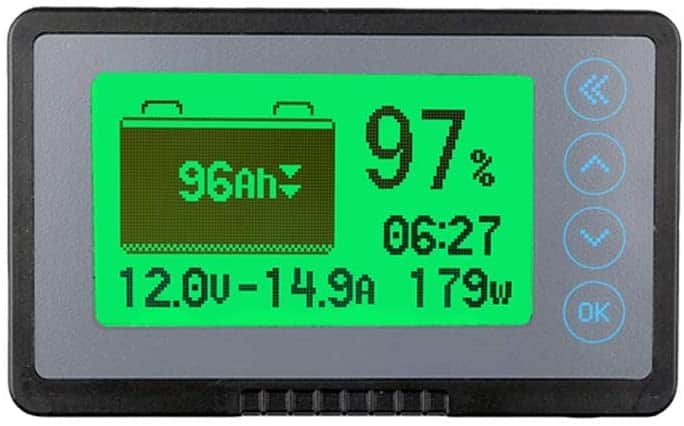
The AiLi 500A Battery monitor is a universal battery monitor that can be used for all types of lead-acid batteries as well as lithium. Unlike using a multimeter, you have to wire and install the monitor or have a professional do it for you. Though once installed, you will be able to see voltage, current, ampere-hours, state of charge (SOC), power time remaining, and power consumption in watts at a glance from the comfort of your RV.
From a price standpoint, the kit costs around $70 on Amazon. However, if you are not an avid DIYer who feels comfortable installing this yourself, you have to add the cost of having it installed to that.
Innova 3721 Battery and Charging System Monitor

The Innova 3721 is great if you are looking for a more plug-and-play method to monitor your battery’s state of charge inside your RV. Most RVs have one of those 12V car ports in them to run things like 12V TVs, heating blankets, and other appliances.
This $20 device plugs into that port and displays the voltage of your batteries just like a multimeter. All you have to do is refer to the voltage tables for your battery type. (If you’re using two 6V batteries wired in a series, the 12V table applies).
Note: If you are in a motorhome, make sure you are plugging this monitor into a plug powered by your house batteries. The 12V car ports located on your dash are most likely powered off your starter battery rather than the one(s) your RV uses.
Easily Downloadable DoD Table For All RV Batteries
Below, you will find all the tables used in this article in one easy-to-reference image. Just right-click on the table and choose “Save Image As” to download it for later use.
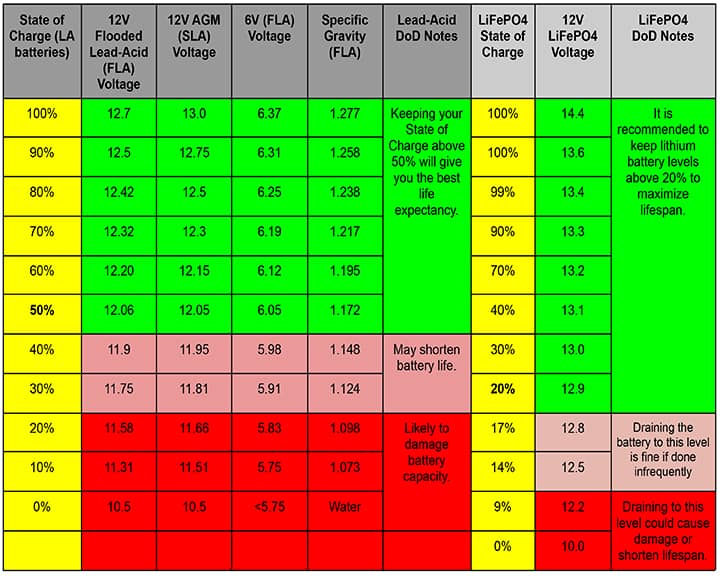
Have you ever measured how much battery power your RV batteries have left? How did it go? Share below in the comments.





Finally a simple to understand article on batteries and state of charge and how to check
Yay! Glad you like it.
Deep cycle lead acid batteries are not “damaged” by deep discharges. While cycle life is impacted, that reduced cycle count is accompanied by ever *increasing* power delivery, making the net service life Ah delivery very consistent across all discharge depths (less than 10% difference). The only true damage that occurs is when the battery is discharged below 10.5V, but practically speaking most RV equipment won’t operate at or below that point anyway. Deep cycle batteries can deliver hundreds of 100% discharges which may represent more operations than a typical user will employ, making this admonition to minimize usage to 50% a moot point. The battery will expire before cycling will wear it out. All that “rule” assures is users will end up buying twice as much battery as they actually need or take unused capacity to the recycler when they expire from age or other trauma.
I mounted a $7 digital voltmeter (with a switch) just inside the door of my A-frame camper to track the batteries (2 GC-2s) while camping. 12.6 is full charge, and each 0.1 volt down from that is very approximately 10% battery capacity down. 12.1V is 50%, and I try to avoid going much below that if I can help it.
When plugged into shore power, the voltmeter tells me the output voltage of the converter. With a Progressive Dynamics 4130 converter, the output voltage is a reasonable indication of the battery’s charge while charging. 14.2 – 14.4V is less than 90%, 13.6 – 13.8V is 90-100%, and 13.2V means batteries are fully charged.
Thank you! My new RV has Lithium batteries and I don’t understand the gauge because it shows volts and I don’t recall seeing a guide in my manual. I just printed off the color chart and will laminate it for my RV!
Glad to help, Dave! Happy RVing!
NOTE; FLA batteries can take on a “Memory Charge” also NICAD will do the same but less used in this situation. If the FLA is keep charged & not allowed to discharge to a low DoD every so often. The recharging is the key, in that if you can control the charge current, you can make a FLA battery last much longer with more cycles. What I am saying; take the 6 volt gulfcart battery & instead of hitting it with a 100 amp charge when low state of charge you limit the current to 5 to 10 amps for a longer time You will place a “Hard” charge on the plates & not knock off material = Pb & PbSO4 & PbO2 that in time will fall to the bottom of each cell = battery mud, this will start to short out the cell. Thus making the FLA battery last longer. Monitor your current draw & charge & try nor to have high current flows. This is where the solar cell panel of 100 watts is great to charge your cabin batteries.
Memory charge; I have experienced this, had a large FLA in my 19′ I/O boat that I keep charged up & salt water dripped on the resistor that limits current to the coil when running, That resistor went open & I found out that this battery would only crank over that Chevy 2 Merc-cruiser for about 4 minutes. Another case was working for GTE in a new CO where these very large single cell FLA batteries were to hold the office for 48 hours but when needed to 6 years later they only held the CO for 5 hours & the Hydrometer balls in each cell showed all 4 were floating & was the same with my boat battery.
In your How to Measure The Specific Gravity you state that “Safety first! Battery acid is very harmful to your skin.” and then you say to squeeze the bulb after inserting it in the cell. While I’m not familiar with that brand of hydrometer the ones I have used required squeezing the bulb _before_ inserting into the battery cell. Squeezing after insertion is analogous to “blowing bubbles” with a straw in a bottle of water but with more severe consequences. Does this hydrometer prevent that?
That would in fact be safer to press, dip, then depressed. I changed the wording around, thanks for the comment.
Another important reason not to let a lead acid battery discharge below 50%, especially during winter storage, is that it can freeze and ruin the battery.
Volts & DOD is nice, but can a good estimate be made of how long (hours/minutes) the batteries will last based on the load applies. I’m thinking a 100 Ah battery should last 50 hours (2 days say) if a couple amps on average is used. I got about 4 hours on my coach batts (batts are isolated when volts reach 10.5) recently with a gas furnace fan running about 10 minutes on/5 minutes off, a 12 cu-ft residential frig (not propane capable) not opened, and a small 1.5 cu-ft outdoor kitchen frig not opened. I know of no other ‘ghost’ items that would be of significance to the power draw? Hydrometer shows all cells are ‘OK’. Thanks….
This does not tell how to tell how many amp hours you have left on a aging battery. That requires a load test.
While DC won’t shock you…it is a Bad habit to get into touching the contacts of your meter leads….
Notice the kithium battery has very small differences in voltage between 99% charged and 70% charged, or between 70% charged and 30% charged. This makes using a voltmeter to gauge the depth of discharge on a lithium battery all but useless – a small load can make that much difference in just the wire loss between the battery and measuring device.
The only way to accurately measure how much charge remains in a Lithium battery is to use an accumulating amp-hour meter like the Ali500 shown above. If you don’t want to run wires between your batteries and the interior of your RV, Vitron makes a monitor that uses a Bluetooth link to an app on your smartphone for the display You only need to insert the shunt between the battery’s negative post and the wires currently on it and run a small wire to the battery’s positive post for power. Several batteries shown at the Quartzsite Big Tent this year had internal Bluetooth monitoring, these only need an app on your cell phone without any additional equipment.
Per Handy Bob Solar Blog;
TM-2030
TriMetric Battery Monitor
Voltage in a lead-acid battery varies with current flowing due to internal resistance in the battery, as well as with timing. If I only had voltage to tell me the state of charge, I would cut off all current draws and charging, wait a while, maybe hours, and then take a reading. The article fails to point out that only a monitor that measures current (in and out) is a quick and reliable approach, and only one of the suggested products provides that.
not sure about your lithium battery at 14.4 volt lithium full charge battery is 12.8 volt